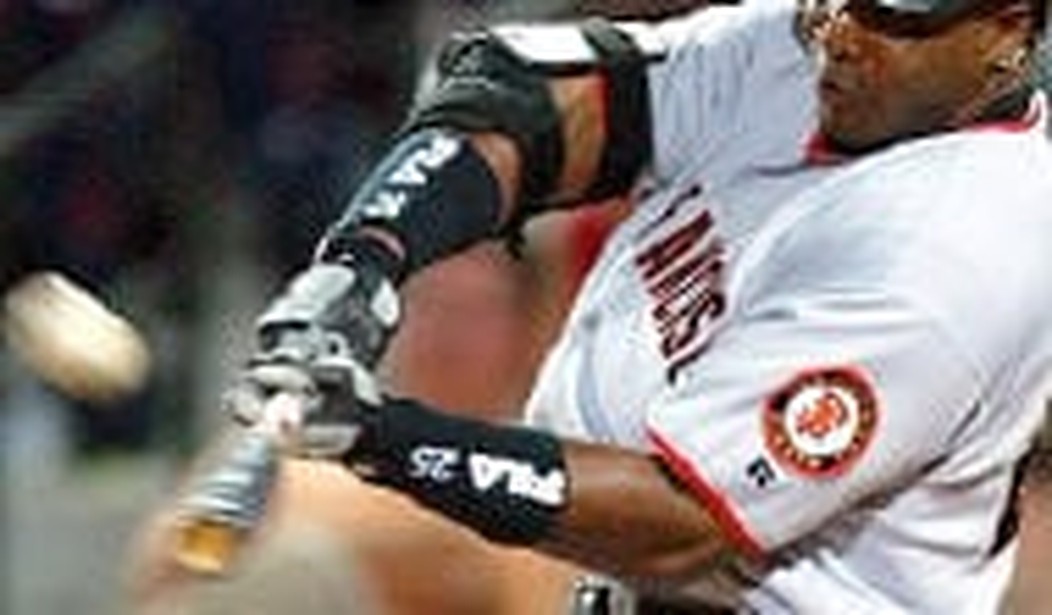Judging by a recent USA Today-Gallup poll, the American people are unconvinced. Only 8% of baseball fans polled believe Bonds is the greatest slugger of all time. And even if he breaks the career home run record of Hank Aaron, that number climbs to only 34%.
Contrast those numbers with a USA Today poll of 493 of the 750 Major League ballplayers. Fully 75% of the pros see Bonds as the best of all time. But both fans and ballplayers agree on one major point; that even if it is proved Bonds took performance-enhancing substances, he deserves a spot in Baseball’s Hall of Fame.
Why the discrepancy between players and fans in their attitudes toward Bonds? Part of it is surely the fact that Barry Bonds is perceived as something of a grouch. His well-known disdain for fans and the media makes him an unpopular player outside of his San Francisco home.
Beyond that, Major League ballplayers are fully aware of something that is only vaguely understood by fans and the media; that Barry Bonds’ feat in hitting 756 home runs is truly one of the more remarkable athletic accomplishments in history.
There is no more difficult task in sports than a baseball batter’s attempt to hit a round ball careening toward him from a little more than 60 feet away, inches from his person, at more than 90 miles per hour with a rounded stick of wood weighing on average 34 ounces. The 5 ounce ball of tightly wound horsehide around a plug of cork can be made by the pitcher when thrown to dip, to shoot left or right, to slide, to flutter, or to hop like a scared rabbit.
As it leaves the pitcher’s hand, the batter has about 2/10 of a second to read the pitch and decide whether to swing the bat or not. In those fractions of a second, the player must decide what kind of pitch is being thrown, how fast it is going to be arriving at home plate, and whether or not the ball will cross home plate for a strike. Being off a couple thousandths of a second means the difference between hitting the ball or not. And the pitcher, God bless him, has other tricks up his sleeve as well. He can change speeds from pitch to pitch to keep the hitter off balance. He can change the angle of his arm when he delivers the ball – coming “over the top” or “dropping down” and slinging the ball almost sidearm. This will change the rotation of the seams against the air between the mound and home plate causing the ball to shoot across the plate while diving downward.
The ball can also be made to curve so that when leaving the pitcher’s hand, the sphere appears to be making a bee line straight for the batter’s head only to fall harmlessly, knee high, over the outside corner of the pentagon-shaped home plate. The flight of the ball toward the hitter’s noggin initiates the “fight or flee” reflex deep in the primitive medulla oblongata, causing the batter’s rear end to begin to skedaddle and the knees to buckle in anticipation that trying to flee from the white demon would be useless. Meanwhile, 50 million years of cognitive mammalian evolution is screaming at the rump to stay put and swing the damn bat because the pitcher is making you look like an idiot.
The result? A brain cramp that causes the batter to freeze like a side of beef in a Kansas City meat locker while the ball drops gently over the corner for a called strike. The pitcher tries not to smile too broadly because he knows that the next curve ball he throws may not be so perfect. He may, in fact, make a slight error in the way he delivers the pitch and instead of curving, the ball will hang over the middle of home plate like a ripe plum thigh high, at which point the batter will swing, connect, and send the ball into the next zip code.
Thus be it ever the eternal battle between pitcher and hitter.
If hitting a home run were simply a matter of being good enough to swing the bat and hit a 90-mile-per-hour fastball, the feat would be even more commonplace than it is today. The fact is, if hitting the ball is a near impossibility, guiding the bat through the “hitting zone – an invisible rectangle that the hitter swings the bat through in order to make contact with the ball – so that the fat part of the bat meets the bottom part of the ball, sending it airborne with sufficient power to make it over the fence is an almost mystical happenstance.
I have taken some pains to describe the difficulties in hitting because pro ballplayers realize all of this and believe Bonds’ feat of hitting 756 home runs is nothing short of phenomenal. And this despite the fact that they are all fully aware of the raging controversy surrounding the Giants slugger and his use of steroids.
It should be said at the outset that there is no doubt Barry Bonds is a steroids cheat. The Feds have him cold. Not only grand jury testimony from a dozen people connected Bonds directly to steroid use, but Victor Conte–owner of the sports “supplement” company BALCO–produced voluminous records tracking Bonds steroid use over several years. The ledgers and calendars Conte gave the Feds show exactly what steroids Bonds took, his levels of testosterone from month to month, and other evidence that left absolutely no doubt that Bonds used banned substances to enhance his performance.
Greg Anderson, Bonds’ personal trainer, originally started the ballplayer on steroids following the 1997 season. Speculation in the book %%AMAZON=1592402682 Game of Shadows%% by Mark Fainaru-Wada and Lance Williams on why Bonds began to use the performance enhancing substances centers on all the attention paid to Mark McGuire and Sammy Sosa when both players were closing in on Roger Maris’ single season home run record. This infuriated Bonds, who had won the Most Valuable Player award 3 times in the 1990’s and was generally seen as the best ballplayer of his generation. He vowed to regain his status that off-season.
Anderson supplied Bonds with the kind of basic human steroids many body builders have used. Winstrol and Deca-Durabolin bulked up Bonds, putting 20 pounds of muscle on his frame and increasing his strength substantially. But early in the 1998 season, Bonds blew out the tendon in his elbow. He had put too much muscle on his arm for the tendon to handle. Clearly, he and Anderson would have to be more careful.
The 1999 season was, if anything, more problematic for Bonds. He felt muscle-bound, unable to turn his body fast enough to be able to hit the inside pitch. He also complained of back and knee problems. Nevertheless, he managed to hit an astonishing 34 home runs in just 102 games – a clear sign that his bulking up was going to pay huge dividends.
In the 2000 season, Bonds added human growth hormone to his cocktail of steroids. This served the purpose of bulking him up while allowing him to maintain his muscle mass without long workout sessions. It also helped him recover quickly from minor injuries. His 49 home runs were a career high that year and Bonds was eager to continue to explore the world of illegal drugs and supplements, seeking to get even stronger and more flexible.
Enter Victor Conte and BALCO. Conte was something of a charlatan, pushing a useless supplement known as ZMA, using famous athletes to market the product. What the Feds discovered later was that Conte paid those athletes by supplying them with a very sophisticated, state of the art illegal supplement and hormone regimen that not only bulked the athletes up, but was also designed to be nearly undetectable to the various testing procedures known at that time. Using known drugs like insulin and modafinil, a powerful stimulant athletes used prior to performing, as well as new substances like norbolethone or “The Clear”–an anabolic steroid developed in the 1960’s but never brought to market–Conte carefully monitored his athletes intake using ledgers and calendars to keep track of the various cocktails’ effects on the body. Regular blood and urine testing was also done.
And Barry Bonds was in the middle of all this thanks to his personal trainer Greg Anderson who arranged for Bonds to be supplied with everything he needed through Conte and BALCO.
The results of Bonds’ off season switch to BALCO’s ministrations were shocking. The 2001 season saw Barry Bonds hit an astounding 73 home runs, shattering the record of 70 set by Mark McGuire (another ballplayer bulked up by anabolics) just 3 seasons earlier.
The next two seasons saw Bonds hit 46 and 45 home runs respectively. Pitchers refused to pitch to him. He walked an astonishing 198 times in 2002, 178 in 2003, and amassed a mind boggling 232 walks in 2004 while still being able to hit 45 home runs.
But by 2004, the string had run out. Conte and Anderson were arrested in late 2003 and Conte told investigators everything they wanted to know – including the participation of Barry Bonds in the hormone and steroid program at BALCO. Bonds himself denied everything before a grand jury. He thought he was taking “flaxseed oil and arthritis cream.” Testimony by a former girlfriend and others however made Bonds out to be a liar. Perjury charges have not been forthcoming, although the prosecutor is still looking into the matter.
So what is Barry Bonds? Greatest slugger of all time? Or a cheat who doesn’t deserve the accolades and homage of Major League Baseball?
Much depends on the unknowable fact of just how many more home runs Barry Bonds hit as a result of his steroid use. Prior to the 1998 season, Bonds was considered to be the greatest ballplayer of his day. He could hit for average, hit for power, run, catch, and throw, and had an instinct for the game’s nuances. But he was not one of the game’s feared sluggers. Like Hank Aaron, he was extraordinarily consistent in his home run output from year to year. In the 12 seasons previous to 1998 Bonds hit more than 400 home runs. The seven years he was taking illegal supplements, he hit 329 home runs. On the surface, this would seem to close the case. But there is much more than meets the eye.
Those seven years correspond to a Major League ballplayer’s most productive years. The player’s experience and knowledge of the competition around the league gives him an advantage he didn’t have in his youth. While Bonds was using steroids, he was also working out harder than he ever had in his career. How much of his increased power output was attributable to steroids and how much to experience and his own efforts to get stronger? We’ll never know.
The argument of the baseball purist has the Bonds matter as an open and shut case; he cheated, ergo all of his accomplishments are bogus and should not be recognized. But steroids do not give a hitter the extraordinary hand to eye coordination that Barry Bonds has. Nor do supplements give Bonds the uncanny ability to guide the bat through the hitting zone so that he hits the ball flush enough to send it out of the park. Increased strength may have assisted in some of his home runs. But strength does little good when trying to hit a curve ball.
My own sense is that Barry Bonds would have hit close to 700 home runs even without the steroids. Those kind of gaudy numbers would make him a sure-fire, first-ballot Hall of Fame inductee. The fact that he felt it necessary to cheat would have made his story a tragic one if Bonds himself wasn’t such a grossly unsympathetic character.
Thankfully, we get to choose our own heroes. And while Bonds will probably break the home run record this year, most fans will recognize that while certainly a great accomplishment, the feat has been irrevocably tarnished by the vanity and hubris of a man who sold his soul when it wasn’t even necessary.
Rick Moran is the proprietor of Right Wing Nut House, and has previously written for Pajamas Media The Sunshine of our Lives, and “300” Reasons to Watch the NBA Playoffs.










Join the conversation as a VIP Member